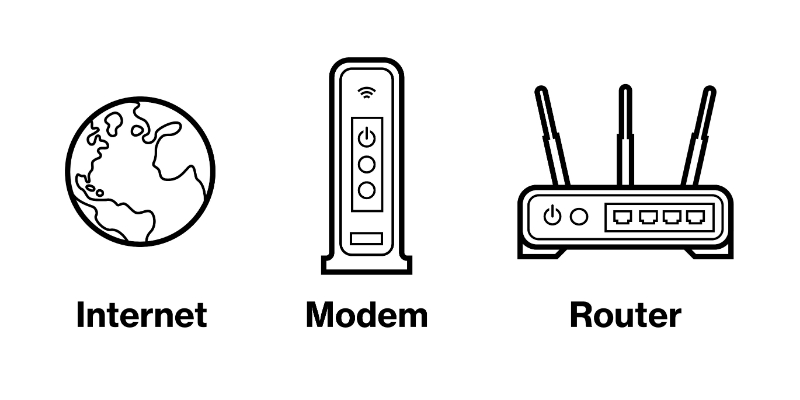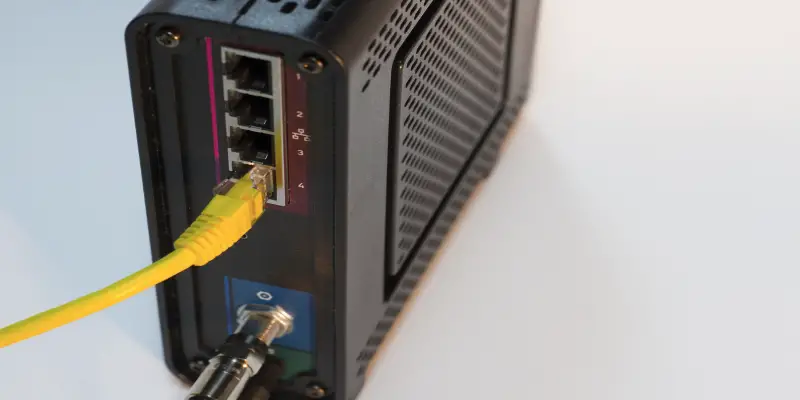Disclaimer: This post may contain affiliate links, meaning we get a small commission if you make a purchase through our links, at no cost to you. For more information, please visit our Disclaimer Page.
As our homes become more connected with WiFi, we may be tempted to get more than one modem. We might have a lot of people in the house, or we might want to have a backup in case something goes wrong.
People can have more than one modem, but a second modem implies acquiring a new internet service. Though, if the range of connection wants to be expanded, a router can be connected to the modem so more devices can connect to the internet. Also, a second router can be connected too.

Table of Contents
Can I Use 2 Modems in The Same House?
Modem is short for modulator-demodulator. A modem is a transmission device that transforms data from one format to another, so diverse device can communicate between them.
Modems receive their names because they modulate different carrier wave signals to encode the information and then transmit it, and at the same time, they demodulate wave signals to decode the data that is transmitted.
Modems can simultaneously encode and decode digital information to allow communication between radio waves. They can complete both tasks, modulating and demodulating the information that will be transmitted or the one that is received.
Two modems can be used in the same house, however, a second hard line of internet service will be needed. Every ISP (Internet Service Provider) just allows one modem per account; so, if someone wants to acquire a second modem, a second internet service has to be paid!
What is the difference between a Modem and a Router?
So, a second router can be added to the same network using the same internet service. However, a router and a modem are not the same devices, and they shouldn’t be confused.
A router is a device that connects to various devices simultaneously.
This connects the devices to the internet by downloading and uploading data from the devices to the internet traffic. A router transmits and directs the data over the network.
Additionally, when this data is forwarded from one router to another router, they create an inter-network until the data packets reach their final destination.
A modem is a device that connects a specific network to a wide area network (WAN) and the internet.
A modem can provide internet to one device at a time, so routers are used to allow other devices to connect to that network.
As said before, modems can encode and decode digital information simultaneously that allows communication between that specific computer network to a WAN.
In a home, one of the routers is connected to the modem, and the router provides Wi-Fi to a specific number of devices in their range.
Then, another router can be added to expand the range, and as result, they make up an internetwork that allows the connection –and the exchange of data– between different computer networks.
In simpler words, a router provides Wi-Fi to several devices at the same time, and the modem provides internet and/or WAN to a specific device or the router itself.
Subsequently, two or more routers can be used at the same time to expand the range of connectivity of the internet provided by the modem, allowing more devices to connect it, and creating it all together an internetwork.
Can I Add a Second Modem to My Network?
A second modem will create its computer network if these have separate account internet services.
Though, if there is one internet service, one of the modems can be used as a bridge, and connect both modems through an ethernet cable. However, remember that a modem will provide an internet connection to one device at a time.
The modem connects a specific device to an Internet Service Provider (ISP). When two or modems are connected simultaneously, one is directly connected to the ISP and WAN, while the other works as a bridge until they reach their final destination.
However, using several modems as bridges in a network doesn’t improve the connectivity nor the internet speed; besides, if these want to be used to “cover more area”, this can be accomplished by using a longer ethernet cable.
When a modem works on its own, this will be able to constitute one single computer network, and all the devices that constitute that network will communicate through wired connections. However, the modem will provide the internet just to one of these devices, not to all of them.
But, using two or more routers will expand the Wi-Fi range, and at the same time, they will make up inter-network.
WiFi allows different devices to connect at the same time to the internet traffic; the upload and download speed of the data will depend on the internet service provided, and when more devices are connected the internet speed will decrease.
A router will create a WLAN (Wireless Local Area Network). This will allow communication between several devices at the same time. Nowadays, a router can connect over 250 devices simultaneously.
The latter uses radio frequencies of 2.4 GHz and 5 GHz to exchange data between the devices and the router.
Routers have an adapter to encode –or decode– the data and transmit it through a radio signal using an antenna. The range of a router depends on different factors; this mostly will decrease if there are objects that obstruct the connection; however, routers have a connectivity range of 100 ft.
If more routers are added, the range will increase, and consequently, they will constitute inter-network. An interwork is created when different computer networks are connected.
However, having more routers does not necessarily improve the internet speed; they just will expand the range where the wireless devices can connect, but when more devices are connected, the internet speed will decrease.

How Do I Set Up a Second Modem?
Routers are connected to modems to expand a network, and allow more devices to connect to the internet. Though, it is not hard connecting a router to a modem, just follow the next steps:
- Connect the ethernet cable to the router’s WAN port, and the WAN port of the modem.
- Use a second ethernet cable to connect the router to the computer. Connect the cable from the router’s LAN port to the computer’s ethernet port.
- Turn on the modem and router. Then, on the browser, type the router’s IP address, and log in using the username and password. The user’s manual should include the IP address, username, and password.
- Make sure that the DHCP is enabled on the Network settings. If not, turn it on.
- Now, verify that the computer is connected to the internet but searching for anything on the web.
Now, to connect a second router, it is only needed to:
- Connect the second router with an ethernet cable to the computer.
- Check the router’s account by typing the IP address on the browser, and logging in.
- Make sure that the DHCP is disabled on the Network settings. If not, turn it off.
- If the second router has the same IP address, assign a new one to the second router.
- Disconnect the second router from the computer, and unplug it from the power.
- Now connect the two routers by connecting an ethernet cable to the LAN ports of each router.
- Plug the router again, and that’s it!
We also have a few articles on router and modem placements. Whether it is in a cabinet, next to the window, or in the closet, check them out!
Conclusion
A modem modulates and demodulates information that connects one device to the WAN, but if one or more routers are added, more devices can connect to the internet. However, as many devices are connected, the internet speed may get slower.
